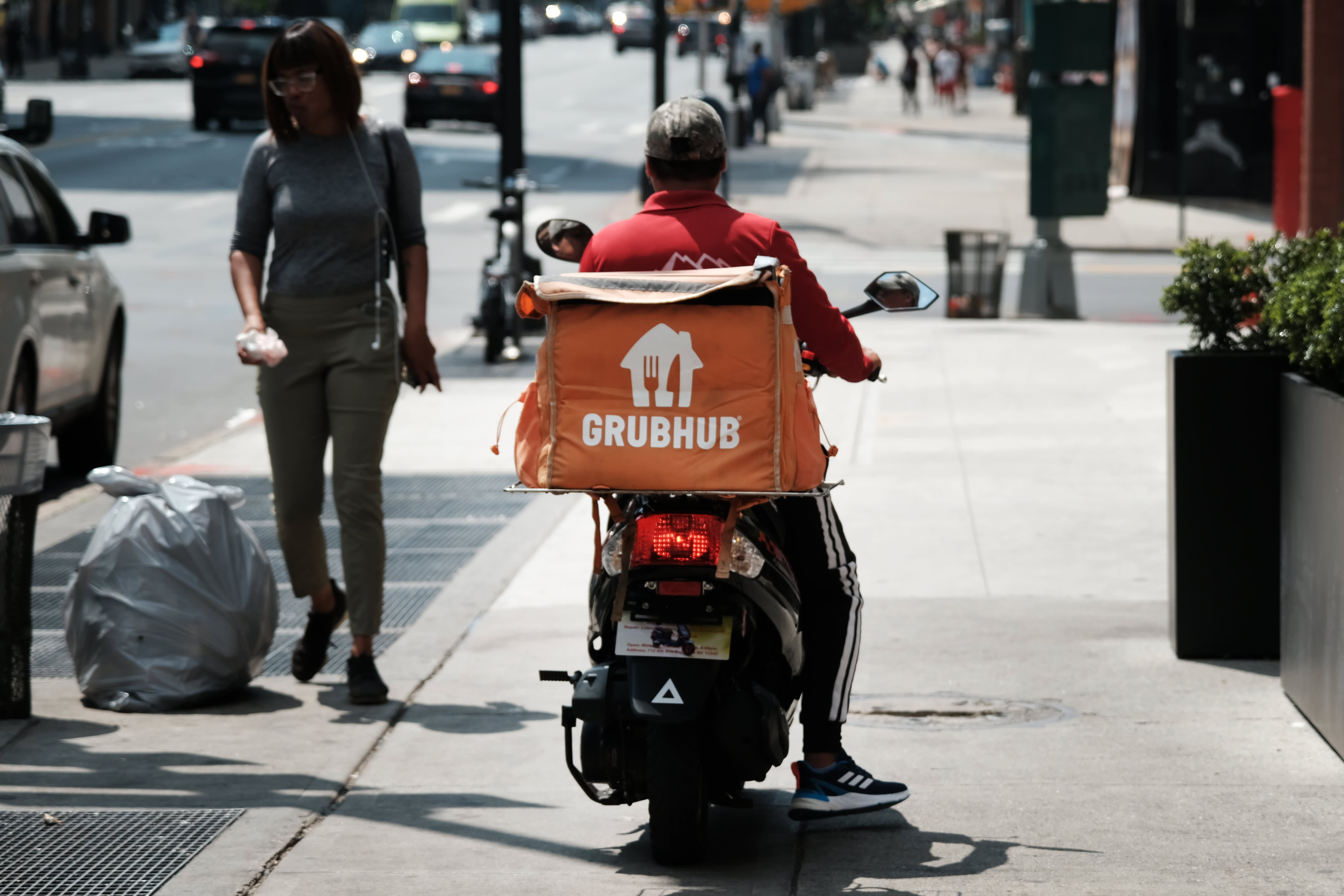
A food delivery messenger is seen in Manhattan.
Luiz C. Ribeiro | New York Daily News | Tribune News Service | Getty Images
Food from the restaurant of your choosing, delivered right to your door — at what cost?
Third-party food delivery is becoming the norm for American consumers, as delivery apps like Grubhub, DoorDash and Uber Eats take hold in day-to-day dining. It’s also presenting customers and restaurants with an increasingly complicated equation of service fees, delivery costs and worker tips.
Frustrations from both sides of the table have hit the services, which have worked to protect (or achieve) profits and prop up orders while cash-strapped Americans scrutinize the checkout screen — and order totals that often add up to more than expected.
Compared to orders made directly through restaurant sites, consumers reported higher yearly increases in their total checks on third-party apps between 2022 and 2024, according to Technomic. Though Uber Eats, DoorDash and Grubhub each promote paid memberships to reduce fees, consumers still claim to pay more on average for third-party orders, according to the food service industry research firm.
The rising costs come as more Americans watch their wallets during a period of persistent inflation.
San Francisco resident Zainab Batool, who said she orders delivery from either Uber Eats or DoorDash weekly, called the added fees “insane.”
“I feel like I remember a time when they used to not be as high, maybe four years ago, but it just seems like it keeps increasing,” Batool said.
The share of consumers choosing third-party delivery services over direct restaurant delivery is rising, up from 15% in 2020 to 21% in 2024, according to Technomic’s 2024 Delivery & Takeout Consumer Trend Report. The research firm found that superior order tracking, access to deals and promotions, and the ability to discover new restaurants has kept app customers coming back.
But the cost of added fees could be driving some of them away.
Among consumers who report ordering less delivery, 41% said it was because of high delivery fees, while 48% point to inflated menu prices, according to the report. The premium that restaurants were charging for third-party delivery service menus increased between 2022 and 2023 — and has nearly doubled since 2020, according to a study by Gordon Haskett Research Advisors.
Companies facilitating the delivery say they aim to keep fees down — at the same time they’re trying to stay afloat.
Grubhub said in a statement it aims to keep fees as low as possible, while maintaining its business: “As the costs associated with handling deliveries — including managing logistics and paying delivery partners — have risen, we’ve adjusted our fees accordingly,” a Grubhub spokesperson said.
The company is owned by Just Eat Takeaway, an online food ordering and delivery company based in Amsterdam, which has said it’s actively looking to sell some or all of Grubhub.
DoorDash said it’s lowered fees for consumers over the last two years of historic inflation, at the same time seeing an all-time high of active users and an increase in order frequency last year.
That company, which went public in 2020, has yet to post an annual profit. The delivery service reported a single quarter of profit — net income of $23 million — for the three months ended June 30, 2020, at the very beginning of Covid lockdowns in the U.S.
Mobility giant Uber, on the other hand, earned nearly $1.9 billion last year, driven in part by major gains in its delivery business. Uber’s delivery segment, which includes Uber Eats and Uber Direct, reported adjusted EBITDA of $1.51 billion for 2023, an improvement of more than $955 million from 2022.
A spokesperson for Uber said Uber Eats users are paying for a service that allows them to browse merchants and order efficiently with on-demand delivery.
“The fees for orders on Uber Eats help pay delivery people and cover platform costs — like safety programs, 24/7 support, background checks, product development, and more — so that orders can arrive reliably,” the spokesperson said in a statement.
Adding up the fees
For diners, doing the math across platforms is getting trickier.
On both Uber and DoorDash, order totals can vary by region because of additional fees applied to offset local laws and regulations, according to their respective websites. In California, for example, customers on Uber Eats pay a CA Driver Benefits fee, introduced to fund mandatory benefits for drivers following Prop 22, according to Uber.
An app-based delivery worker waits outside of a restaurant that uses app deliveries on July 07, 2023 in New York City.
Spencer Platt | Getty Images
Even before local variances, the add-ons can be daunting.
Uber collects a delivery fee, which varies depending on demand, location and driver availability, according to its website. DoorDash applies a similar delivery fee that it said is dependent on multiple factors. Both apps say this fee is paid directly to them to cover delivery costs, rather than the drivers or restaurants. Grubhub also includes a delivery fee on orders that increases with distance, up to a maximum price.
All three apps also charge a separate service fee, which isn’t much simpler to calculate.
Grubhub and DoorDash say the fee covers the cost of operating their platforms, Uber says all but 10 cents of its service fee goes directly to the delivery driver, though the driver is then expected to pay Uber an undisclosed amount for various support services.
Both DoorDash and Uber say the fee can change based on the order subtotal.
After all of those variations, and factoring in possible discounts or promotions, many customers won’t know the total cost of their order until they’ve selected their items and made it all the way through to checkout.
“You see something listed as 15 bucks and then you go to checkout and it adds up to, like, 25, but you’ve already kind of in your head committed to getting that thing or you’re looking forward to it,” app user Batool said. “It adds an extra friction between backing out of ordering.”
Both Uber and Grubhub said their fees are clearly disclosed before checkout, while DoorDash said the total applicable fees are consistently available to view in the cart.
Weighing the economics
For restaurants, part of the value proposition of third-party delivery services is the potential for more exposure and customers, according to Bentley University assistant professor of marketing Shelle Santana.
More than 1 million merchants partner with Uber Eats, and over 375,000 work with Grubhub, according to the companies. DoorDash said in 2023 it had over 100,000 new merchants join its marketplace, generating nearly $50 billion in sales for the businesses. Uber Eats merchants in the U.S. and Canada brought in more than $15 billion in sales last year through the app, according to Uber.
For restaurants to be listed on their respective marketplaces, Uber Eats and DoorDash each offer a tiered pricing structure with commission charges ranging from 15% to 30% of the order total, according to their websites. Restaurants joining Grubhub Marketplace pay a “marketing commission” between 5% and 10% of each order, as well as an order processing fee and 10% delivery fee, according to its website.
We Deliver, Doordash, Grubhub and Uber Eats signs on restaurant door, New York City.
Lindsey Nicholson | UCG | Universal Images Group | Getty Images
All three platforms say restaurants can choose from a variety of pricing plans, based on the rate and level of marketing support they want, including commission-free online ordering services.
Tony Scardino, the owner of Illinois-based Professor Pizza, said he uses multiple third-party delivery services at his two Chicago locations, including Grubhub, DoorDash and Uber Eats. He’s used the services for almost four years and said the apps’ pricing is “predatory” and “way too much.”
But using their delivery services instead of paying for in-house delivery is worth it for a business on the smaller side, he said. It all adds up to what he called a “difficult balance.”
“You fight with whether or not you should get on them in the first place,” Scardino said. “But, you have such an overwhelming audience of people on them that it’s hard not to.”
The cost can in turn force restaurants to raise their menu prices.
In a study of the menu pricing premiums for 25 popular restaurants on third-party delivery services, the average cost was 20% higher than dining in, according to Gordon Haskett Research Advisors.
“Restaurants have sort of said, ‘We’re not footing the bill for DoorDash and Uber and Grubhub. The consumer, if they value that convenience and wants to use that service, can foot that bill,'” said Empower Delivery CEO Meredith Sandland.
Empower Delivery aims to rival the major delivery services, connecting restaurants with a pool of delivery workers at what it claims is a lower cost for business, according to its website.
Ann Arbor, Michigan, restaurant owner Phillis Engelbert has resisted DoorDash and other third-party delivery services since before the pandemic. She said her Detroit Street Filling Station relies on dine-in orders and a limited delivery option with a flat $7 fee.
Even if they led to higher sales, Engelbert said she is not convinced third-party delivery apps would improve her bottom line or benefit her employees.
“It feels like another way that corporations can come in and take a chunk out of the fruits of our labor,” Engelbert said.
Flexing savings
As more restaurant owners pass the delivery app costs over to consumers, the third-party services have all ramped up monthly membership options to help alleviate some of the pressure.
All three major services offer free delivery on every order with their premium memberships — Grubhub+, DashPass and Uber One — at $9.99 a month, according to their respective websites.
Grubhub struck a deal with Amazon for the e-commerce giant to offer Prime users in the US a one-year membership to its food delivery service. Photographer: Gabby Jones/Bloomberg via Getty Images
Gabby Jones | Bloomberg | Getty Images
In May, Grubhub partnered with Amazon to include Grubhub+ in the e-commerce giant’s Prime subscription. DoorDash offers a free yearlong membership for users with a DoorDash Rewards Mastercard, and Uber offers membership benefits for certain Capital One credit cardholders for a limited time.
They also all offer incentives for students: DashPass and Uber One are half-priced, and Grubhub+ is free for students at partner universities, according to their respective websites.
The benefit of the subscriptions is twofold: With the promise of lower all-in order costs, more customers may make it to checkout, and more often; and with a curated list of power users, the services can tailor future discounts to their most loyal customers, according to Steve Tadelis, a professor of economics at UC Berkeley.
Though the subscriptions all eliminate delivery charges, the service fee — and any local variations — still applies. The service fee is lowered for DashPass members, according to the company.
And if you’ve made it this far, that leaves just one cost left: a tip for the delivery driver.
When consumers are surprised by the total price tag, tipping can be “the only lever they have left” to manage their budget, according to Empower’s Sandland.
Batool said that she always tips, but that doesn’t mean she feels good about it given the other fees applied. She said that because she can’t be sure whether the service fee and other charges are actually going to the drivers, tipping is necessary to be sure that they’re compensated.
“It makes me mad, because I feel like the service fees should be going towards the people who are servicing us,” she said. “But it doesn’t seem like it is.”

